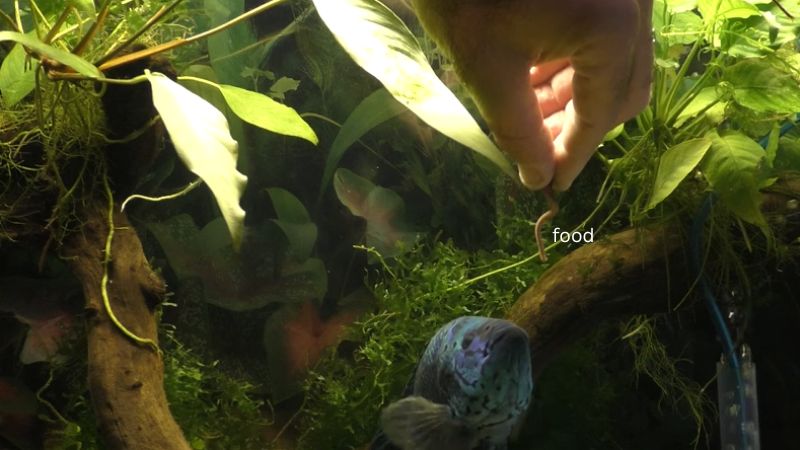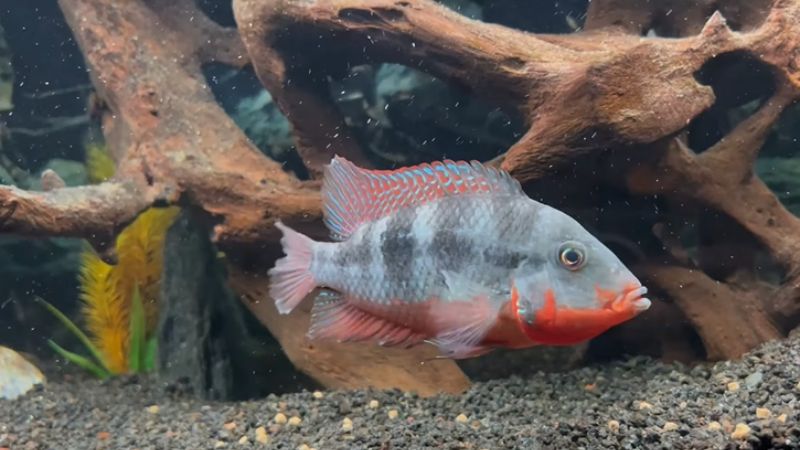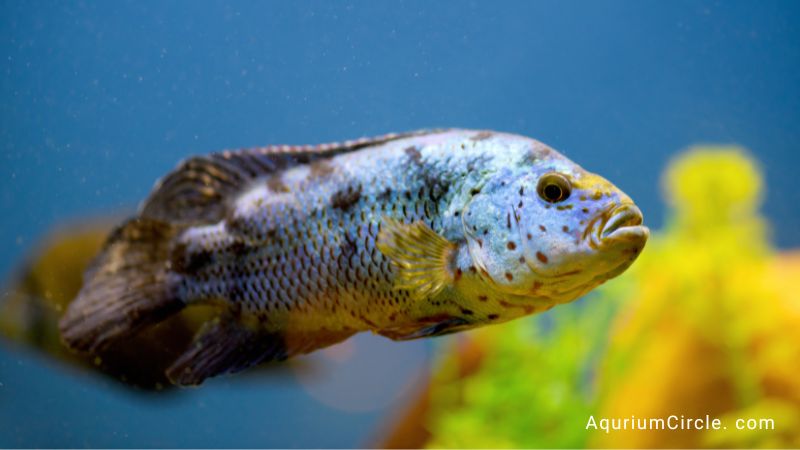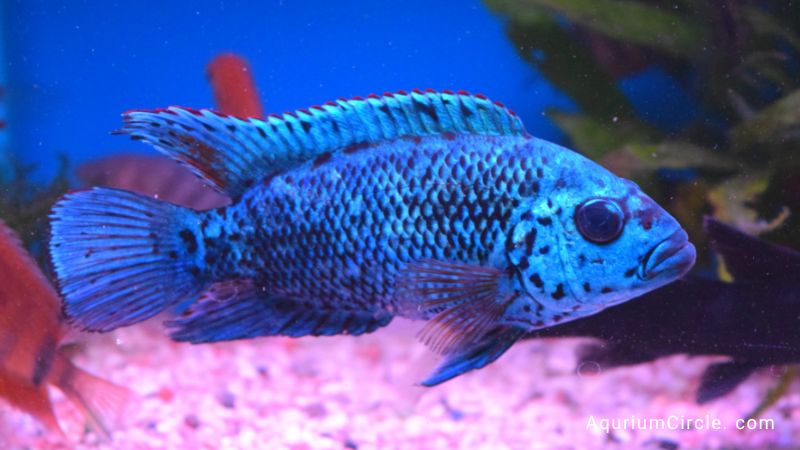A distinctive and eye-catching fish that has gained growing acclaim among freshwater fish aficionados is the Electric Blue Jack Dempsey. This fish is a Jack Dempsey cichlid variety that stands out from its more prevalent brown or gray-colored siblings thanks to its vivid blue color. For those searching for an eye-catching and intriguing addition to their tank, the electric blue Jack Dempsey is a robust, active fish that can thrive in a variety of aquarium designs. In addition to discussing the essential traits of the electric blue Jack Dempsey, this article will offer advice on how to take care of and maintain these stunning fish.
What Is Electric Blue Jack Dempsey?
Together with other aquarium favorites like Platy fish and Convict Cichlids, they can be found in the wild in Southern Mexico and Honduras. Dempsies love temperatures that are relatively warm and hard, alkaline water.
If you enjoy sports or history, you may be familiar with the name “Jack Dempsey.” The legendary boxer gave the fish their name. In the ring, Jack Dempsey was renowned for his ferocity. The fish earned its moniker because it was one of the meanest you could find when it first became a hobby. But, there is currently a lot of Dempsey fish that are much meaner than the Jack Dempsey that are traded. Like the Red Devil, Red Terror, and Wolf Cichlid, they frequently use evocative names.
Electrifying Blue A variant bred for a more vivid blue color is Jack Dempsey. They also have long, delicate fins and bright red eyes. Compared to typical Jack Dempsies, they are weaker. Yet the additional effort is totally worth it.
Electric Blue Jack Dempsey Appearance
The Electric Blue Jack Dempsey’s head is much larger than his body. They have expressive, big eyes. Their body is primarily blue, with flashes of black, neon blue, pale blue, and blue-white colors occasionally appearing. Their mouth has labial arches around the edge. The fish has a dark brown backdrop with a black body that is speckled with broken lines. The Electric Blue Jack Dempsey’s dorsal and anal fins are quite important.
Fish that are younger have drab colors, which improve as they age. Yet, like other fish, adult fish lose their shine and develop softer hues when under stress. Adults can reach a height of 8 inches and typically survive for 10 to 15 years.
Males and females look very different from one another. Male fish have richer hues and can have black markings on their bodies or tails. The majority of their body appears metallic and bright. In addition, males have more pointed and longer dorsal fins than females.
Electric Blue Jack Dempsey Caring
A bit more effort is required to care for an Electric Blue Dempsey cichlid than for a regular kind. But the benefits outweigh the costs.
Suitable tank size for Electric Blue Jack Dempsey
This species of cichlid needs a large aquarium. More swimming room is available in a larger tank, which also preserves water quality via the dilution of fish waste.
Jack Dempsey is a medium-sized cichlid. Not too little, but not too big either. For a single adult or breeding pair of Electric Blue Jack Dempseys, I strongly advise a breeder tank no smaller than 40 gallons. Yet, a 55-gallon tank is cozier.
The best water conditions for Electric Blue Jack Dempsey

Powerful Blue Compared to a regular Dempsey, Jack Dempsey fish are a little pickier about their aquatic environment. They both favor neutral to slightly alkaline water (pH 7.0-7.5). You don’t need to make many changes because tap water in most nations is alkaline.
The Jack Dempsey Electric Blue cichlid has difficulty in that it is more sensitive to increased nitrogenous waste. With a common aquarium test kit, the levels of ammonia, nitrite, and nitrate must be monitored.
This shouldn’t be a problem as long as you maintain a regular schedule for water changes and filter maintenance. Jack Dempsey is a carnivore. Thus, a lot of their feces is ammonia. They are very big fish, so make sure to replace the water frequently.
What To Feed Electric Blue Jack Dempsey?
Powerful blue being carnivorous, Jack Dempsey fish require a diet high in protein to survive. They consume other prey creatures, including tadpoles, worms, shrimp, and smaller fish. Almost any meat-based food, including flakes, pellets, frozen, and live foods, will be consumed by them. Their diet in captivity should mostly consist of protein-rich additions. Reading the ingredients label on fish food is something you should do when purchasing it.
Give your Electric Blue Jack Dempsey a variety of diets if you want to keep them healthy. Almost all low-cost prepared fish meals are filled with substandard ingredients, including corn, wheat, soy, potato starch, and others. For predatory cichlids like the Electric Blue Jack Dempsey, these are unhealthy. Moreover, feeding them twice daily in modest amounts that they can ingest in a few minutes is advised. Avoid overeating because it can cause constipation and bloating, as well as other health issues.
The mouths of cichlids are very big. Fish called Dempseys never stop being hungry. Moreover, a young Dempsey may consume small cichlid pellets as nourishment. Sometimes you should also feed live and frozen food. Make sure to continue changing up their diet so they obtain all the nutrients.
Electric Blue Jack Dempsey Tank Mates
It might be challenging to add the Electric Blue Jack Dempsey to a communal tank. They might not be as volatile as their Jack Dempseys parent family. Yet, they still pose a risk to the tank’s other fish. The Electric Blue Jack Dempseys can cohabit with a select few fish.
The same goes for other huge cichlids in the tank. A 75-gallon or larger medium to big cichlid community tank is a beautiful sight. The better option is a larger tank. Each cichlid will have enough space to establish a distinct area and drive rivals away.

- Firemouth Cichlids: The name of Firemouth cichlids is self-explanatory. They seem to have a band of fire shining around their mouth. During the mating season, they become very protective of their fry and will defend themselves to death.
- Acara Cichlids: Acaras are native to Central and South America, and there are essentially two species. Avoid putting acaras in communal tanks with little, timid fish because they enjoy devouring smaller fish.
- Convict Cichlids: Because of their striped look and reputation for aggression, Convict Cichlids are so named. They are playful, like their own room, and have lots of hiding places, exactly like the Jack Dempseys.
- Jewel Cichlids: They come in hues like red, blue, and purple. More people are familiar with the red or orange variation of the Jewel Cichlid.
- Gourami fish: They are available in various colors and were first discovered in Asia, India, Korea, and Pakistan. They are also known for needing little upkeep, so that is one less thing for you to worry about.
- Severum Cichlids: A member of the Cichlidae family is the several species. They go by a variety of names, such as banded cichlid and gold Severum cichlid. Be cautious since these Cichlids, like the others, may try to consume the smaller fish in the tank.
- Rainbowfish: Freshwater fish called rainbowfish are well-liked in the aquarium industry. Allowing them to be in their own places is the greatest way to prevent any internal problems.
- Angelfish: They have a laterally compressed body structure, which essentially implies they are quite thin, like the majority of cichlids.
- Giant Danios: Their best chance of coexistence is with other semi-aggressive fish because they do not do well with similarly aggressive tank mates.
They should not be kept with other cichlids in aquariums smaller than 55 gallons because they will fight. But, you should include dither fish that are too huge to eat.
Blue Jack Dempsey Breeding

Due to its reputation for being rather violent and possessive during mating, Jack Dempseys can be difficult to handle. To prevent other fish from interfering with the breeding process, a separate breeding tank is advised. Furthermore, providing the fish with high-quality, protein-rich food can aid in improving their chances of having a successful mating season.
Although it is quite difficult to breed an Electric Blue Jack Dempsey pair, if you are willing to try, then this is how it happens. The adult male and female signals are visible before the mating couple is prepared to procreate. Males develop more pronounced and visible copulative organs. The pair should be added to and cycled in a different tank. As noted, maintain a steady tank temperature of 86 degrees F. To increase the likelihood of successful breeding, make sure the tank water is fresh and replenish it every three days.
The female will place the eggs around the tank’s decorations, such as plants, stones, hiding places, etc., throughout the spawning phase. The female will only be able to lay up to 1,000–2,000 eggs at the most for the entire duration. Around this time, you’ll observe that the fish become quite aggressive and fiercely defend their eggs. This is the major justification for thinking about getting a separate breeding tank.
After two to three weeks, the eggs will hatch into fry. They are born with drab, faded colors. When the infants are about two months old, their color will start to improve. The fry is vulnerable to illnesses, infections, and fatal conditions at this time. Increase the temperature by two to three degrees F to ensure their continued health. You can lower the temperature once more once 3 to 4 weeks have elapsed.
FAQs
Are Electric Blue Jack Dempsey rare?
Absolutely, due to their distinctive and distinctive coloration, Electric Blue Jack Dempsey is regarded as unusual in the aquarium trade. They are a popular, readily accessible aquarium fish called the Jack Dempsey cichlid that has undergone selective breeding. Aquarium aficionados greatly prize the Electric Blue Jack Dempsey because of its metallic blue hue and iridescent scales that sparkle in the light. In contrast to other cichlid species, their rarity might make them more expensive and difficult to find.
Is Electric Blue Jack Dempsey aggressive?
Indeed, Electric Blue Jack Dempseys can be hostile, especially when protecting their territory or during the breeding season. They might attack and kill smaller fish in their aquarium. Therefore, it’s crucial to keep them with suitable tank mates and give them enough room and hiding spots.
Are Electric Blue Jack Dempseys hard to keep?
Electric Blue Jack Dempsey needs a tank with particular water conditions and enough room to swim. To thrive, they also require diversified food and an appropriate environment. They might not be the simplest fish to keep for novices as a result, but skilled aquarists with the right setups and knowledge can successfully care for them. Moreover, caution may be needed while keeping them with other fish due to their aggressive attitude.
References:
- Cichlids Bro – https://cichlidbros.com/
- Wikipedia – https://en.wikipedia.org/wiki/Jack_Dempsey_(fish)

Annette M. Chaney is an experienced marine biologist with over 20 years of experience as an aquarist and fishkeeper. She started her first aquarium at a young age, filling it with frogs and goldfish obtained from the ten-cent pet store.
Annette grew up caring for and breeding African Cichlids, which led to a hobby in high school that doubled as a profitable means. Attending Reed College gave her time to solidify herself as an accomplished aquarium caretaker with an eye for sales. After that, from 2009 – 2013, she studied at Roger Williams University – one of the most prestigious universities for Aquaculture and Aquarium in USA. She is the founder of AquariumCircle since 2010.
